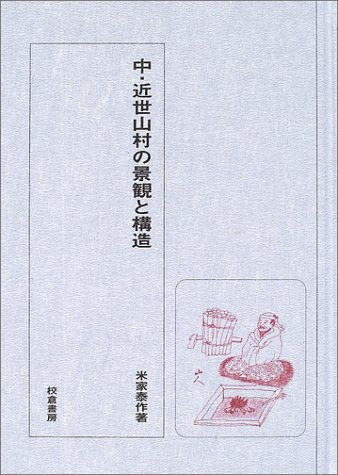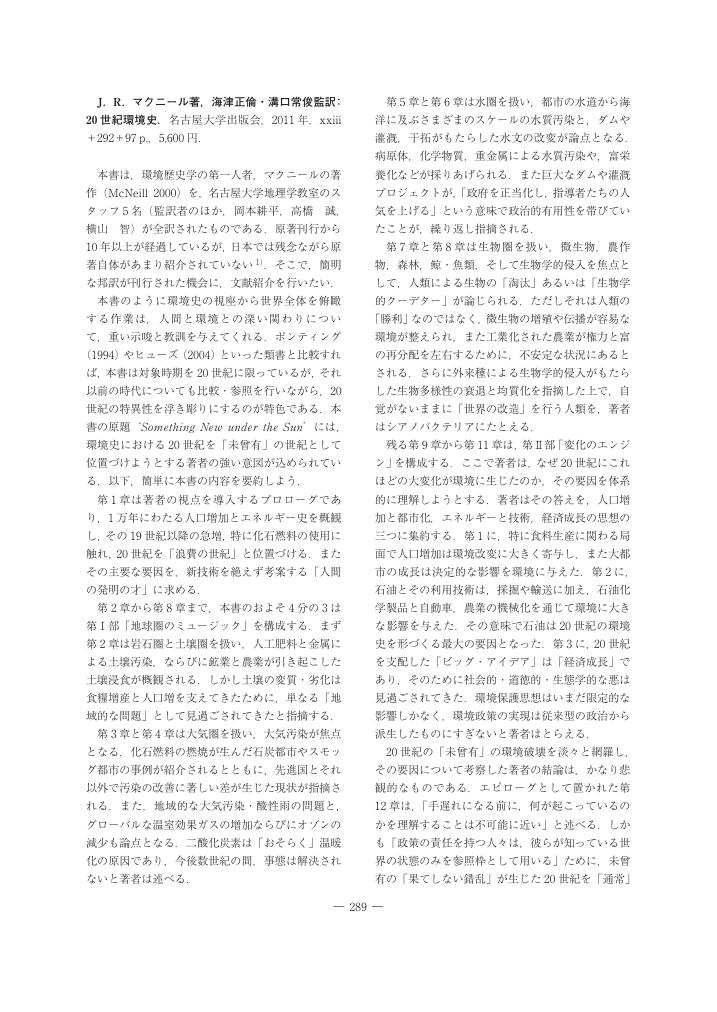7 0 0 0 OA 1980年以降の日本における歴史地理学の動向
- 著者
- 小野田 一幸 宮本 真二 藤田 裕嗣 米家 泰作 河原 典史 川口 洋
- 出版者
- The Human Geographical Society of Japan
- 雑誌
- 人文地理 (ISSN:00187216)
- 巻号頁・発行日
- vol.65, no.1, pp.1-28, 2013 (Released:2018-01-26)
- 参考文献数
- 222
- 被引用文献数
- 1
本稿では,1980年以降の日本における歴史地理学,地図史,および歴史GISに関する主要な研究成果について展望する。この30年間にわが国では,H. C.プリンスによって定義された現実的世界,イメージの世界,および抽象的世界を対象とした豊かな研究成果が生み出されてきた。現実的世界を対象とした研究では,景観や地域構造の復原が引き続き基礎的課題となっている。とりわけ,過去と現代をつなぐ役割を担う近代期の研究意義が注目されるようになった。最新の研究動向として,環境史と学際的研究の進展があげられる。後者については,地理学,歴史学,考古学の研究分野で史資料と研究方法の共有化が進み,歴史地理学の方法論が隣接分野に受け入れられて学際的研究に発展する動向がみとめられる。イメージの世界については,過去に生きた人々の世界観に関する理解を深めるために,1980年代から古地図・絵図研究が本格化した。抽象的世界に関する研究は,歴史GISを活用することにより,21世紀初頭から新たな段階を迎えた。歴史GISは,歴史地理学を含む人文・社会科学における個別研究の成果を統合する「しくみ」としても有用とみられる。
4 0 0 0 帝国日本の林学者と植民地林業の研究
本研究は、明治後期から昭和戦前期にかけての、帝国日本のフォレスター(林学者や林政官僚、林業技術者、林業家)が、本国と植民地(ないし勢力圏)において、どのようにして人材と学知のネットワークを築き、植民地化された人々と接しながら、「帝国林業」を展開したのかを問うものである。さらに、帝国日本が展開した「科学的林業」によって確立した森林保全的な思想が、旧植民地にもたらしたポストコロニアルな影響を検討する。その際、近代科学の発展を帝国主義の空間的な展開のなかで捉えるとともに、イギリス帝国との比較を通じて日本の「帝国林業」の特色を捉える。
4 0 0 0 OA 近代日本における植民地旅行記の基礎的研究 : 鮮満旅行記にみるツーリズム空間
- 著者
- 米家 泰作
- 出版者
- 京都大學大學院文學研究科・文學部
- 雑誌
- 京都大學文學部研究紀要 (ISSN:04529774)
- 巻号頁・発行日
- vol.53, pp.319-364, 2014-03-20
3 0 0 0 OA 近世大和国吉野川上流域における「由緒」と自立的中世山村像の展開
- 著者
- 米家 泰作
- 出版者
- 公益社団法人 日本地理学会
- 雑誌
- 地理学評論 Ser. A (ISSN:00167444)
- 巻号頁・発行日
- vol.71, no.7, pp.481-504, 1998-07-01 (Released:2008-12-25)
- 参考文献数
- 61
近世日本の山村は,幕藩体制に対して,山村の特質を踏まえた独自の論理を主張することがあった.その一例として,民俗学・文化地理学が指摘したような「自立的」な中世山村像を嘆願の論理として活用した近世大和国吉野川上流域の事例を検討する.18世紀の当該地域では,中世期に自立的な政治体制があったことを措定し,その「由緒」を主張することによって「諸役免許」特権の「回復」を嘆願する動きが見られた.嘆願活動はたびたび繰り返されたものの,結果としては失敗に終わった.しかし,村落結合を通じて,「諸役免許」が吉野郡という「郡の由緒」であり,それが中世に由来するものとする論理が,共有化されることになった.この論理を支える中世期の地域像は, 18~19世紀に盛んに作成・筆写された由緒書・旧記に,より詳しく描かれていく.そこでは金峰山寺・南朝と吉野郡との関わりが主題となりながらも,かつて金峰山寺領であった事実は記されていない.むしろ,無税にして武力を誇る政治体制が強調され,それが「由緒」としての「諸役免許」を説明する文脈となっていた.
3 0 0 0 OA 前近代日本の山村をめぐる三つの視角とその再検討
- 著者
- 米家 泰作
- 出版者
- The Human Geographical Society of Japan
- 雑誌
- 人文地理 (ISSN:00187216)
- 巻号頁・発行日
- vol.49, no.6, pp.546-566, 1997-12-28 (Released:2009-04-28)
- 参考文献数
- 225
- 被引用文献数
- 1
The purpose of this paper is to re-examine the history of the mountain area in Japan with special reference to differing viewpoints expressed by historians and other scholars such as folklorists, geographers or ethnologists. This difference of viewpoint between historians and other disciplines is notable. The former has mainly concentrated on economic development and the formation of political systems, while the latter have been concerned with systems and the processes of cultural decline. These two approaches are in contrast with each other, but have the potential to complement each other. Consequently, the author surveyed researches on cultural, political and economic points of view to explore more comprehensive schema.A good place to start is to inquire into the genetical approach to mountainous area culture by folklorists, ethnologists and cultural geographers. Some have advanced the hypothesis that subsistence economies such as shifting cultivation, hunting and gathering, which still remain in modern mountain villages, date back to the Jomon period, that is to say, before the time when paddy cultivation developed in Japan. Assuming this hypothesis to be true, it can be said that the mountain people are successors of the Jomon culture, which is supposed to be the base of all Japanese culture.This opinion begs the question how and when the non-paddy cultural system has been carried into modern mountain villages. It is necessary to discuss this on two points. Is the modern inhabitant of the mountain area, who is isolated from the alluvial plain, a descendant of Jomon people? Has the non-paddy cultural system survived only in mountain areas since ancient times?First, some folklorists emphasize that medieval warriors retreated into the mountain area afther defeat. Some historians have studied the governmental forestry system in ancient times, and reclamations expanding toward mountain areas in medieval times. Results of these researches suggest that we must pay more careful attention to the dynamic process of the immigration from low lands to the mountain area and to their relation with the political and economic context.Secondly, recent historical and historico-geographical studies have recognized the importance of dry field and shifting cultivation in the alluvial plain from ancient to medieval times. We can, consequently, presume that the subsistence economies without paddy had developed both in the mountain area and in the plain, but that in early modern times the cultural characteristics in the mountain area presented a clear contrast with the culture concentrating on rice cultivation in the plain.These points lead us to the question how did non-paddy cultures survive at a time when the strong tendency was to concentrate on rice cultivation in Japan? In other words, what was the relationship between the Japanese political and economic system and the people in the mountain area prior to early modern times?This paper also re-examines the works focusing on the peasant revolts in mountain areas in early seventeenth century. Some folklorists and cultural geographers have suggested that these uprisings happened in the process of mountain people being ruled by the unifying political powers based on paddy cultivation in the plains. However, these revolts were not the first contact between them. Other folklorists pointed out that the mountain people were already ruled by a centralized government in ancient times. Some historians have argued about the medieval territory as a manor or a legal unit in western Japan, and pointed out that the medieval political power had a reason to keep estates in the mountain area to supplement rice production with various products of dry field cultivation, shifting cultivation, hunting and gathering. This way of control contrasts with the early modern political system which demanded timber and charcoal from mountain villages.
- 著者
- 米家 泰作
- 出版者
- 歴史地理学会
- 雑誌
- 歴史地理学 = The Historical geography (ISSN:03887464)
- 巻号頁・発行日
- vol.58, no.1, pp.19-38, 2016-01
This paper examines the politics of national and regional resources in modern Japan, with special reference to the prohibition of the burning of grassland. Afforestation and the reduction of grassland became one of the most important issues in Japanese forestry during the first two decades of the twentieth century. Following the enclosure of the national forest in the late nineteenth century, the Forest Bureau tried to control vegetation nationwide by promoting the afforestation of private or common gen'ya: a category of land cover including grassland, bush, or thin vegetation, which had been artificially kept for the use of green manure, forage, and fuel, but was not useful for modern forestry. The bureau made an effort to calculate the land area of gen'ya and concluded that half of common land was covered with grass or thin vegetation. In 1910, the bureau attempted to encourage forestry by introducing a rule that forbade local people from maintaining grassland through engaging in periodical field burning. This prohibition policy was supported by the silviculturist representation of grassland as a devastated landscape in which the natural growth of plants had been inhibited through the historical custom of fire. Certain academic foresters, including Seiroku Honda at Tokyo Imperial University, promoted the rebirth of original, natural, and productive vegetation. However, the new rule provoked a refutation of agropolitics by some local areas, which had used grassland for agricultural and daily purposes. In the case of Kiso Region, the southwestern area of Nagano Prefecture, local people protested against the rules, by conducting their own vegetation survey to verify that field burning encouraged the growth of useful plants for foraging and supported regional agriculture. This illustrates that the early twentieth-century silvicultural attitude to gen'ya lacked consideration of how this thin vegetation had been artificially maintained in the human-environment relationship, and played an important role in regional economies.
1 0 0 0 OA 秋葉信仰の広がり --秋葉神社の分布に着目して--
- 著者
- 米家 泰作
- 出版者
- 京都大学文学部地理学教室
- 雑誌
- 2017年度実習旅行報告書--浜松市--
- 巻号頁・発行日
- pp.153-160, 2017-12
1 0 0 0 OA 植民地台湾における草創期の林学と田代安定
- 著者
- 米家 泰作
- 出版者
- 公益社団法人 日本地理学会
- 雑誌
- 日本地理学会発表要旨集 2020年度日本地理学会秋季学術大会
- 巻号頁・発行日
- pp.99, 2020 (Released:2020-12-01)
近代日本の林学は,日本が帝国主義への道を歩み始めた19世紀末に制度化され,ドイツ林学を通じて科学的林業の考えを取り入れた。報告者はこの点に留意して,林学の確立と植民地の拡張,ならびに環境主義の関わりについて検討を重ねてきた(米家2019,米家・竹本2018,Komeie 2020)。本報告では,科学的林業の素養がないまま台湾で草創期の林学の基盤を築いた田代安定に注目し,植民地林学の形成にみる本国と植民地の関係性について考察する。田代安定(1857-1928)は,19世紀末から20世紀初頭にかけて、主として植物学や人類学の分野で活躍した人物であり,八重山諸島や台湾先住民の調査で知られる。また,研究者としての側面と,台湾総督府の植民地統治を支えた技官としての側面があり,その多面的な人物像の検討が進んでいる(呉2008,中生2011)。田代と台湾の関わりは,日清戦争時の澎湖諸島占領に随行し(1895年),自生植物の目録と「植樹意見」を作成したことに始まる。田代は創設された台湾総督府に勤め,主として林政と先住民統治に関わった。前者に関しては,街路樹を含む植林の促進と,熱帯植物殖育場における有用植物の研究が大きい。これらは,田代が植物学の知識を活かして熱帯林学の基盤づくりを進め,植民地の開発を意図したことを示している。ただし,総督府における田代の立場は殖育場主任に止まり,林務課や林業試験場の要職には就かなかった。また、田代の関心はもっぱら植栽すべき種の選定と育苗にあり,伐採林業の促進には関わりが弱かった。一方,東京農林学校が1890年に帝国大学に編入されると,ドイツ林学を学んだ林学士の輩出が始まった。林学教室のスタッフの一人,本多静六(1866-1652)は,植民地となった台湾や朝鮮に関心を広げ,帝国の林学を志向することになる。1896年に台湾の山岳植生を調査した本多は,「植物家」のように植物種を単に記録するのでなく,林学の立場から植生の人為的変化を捉えるべきだと主張した。本多と田代は,澎湖諸島の植生の成因について意見が相違しており,植物種に関心を置く田代と,生態学的な視座から森林管理を志向する本多の立場は,対照的であった。植民地台湾に赴任した帝大卒の林学士として,本多と同期の齋藤音作がいるが,数年で内地に戻っている。より本格的な人材として,林務課長や林業試験場長を務めた賀田直治(1902年卒)と,林業試験場長を務め,後に九州帝大に招聘された金平亮三(1907年卒)が挙げられる。他にも帝大や高等農林学校で林学を修めた人材が,次第に台湾の林政に加わるようになると(呉2009),林学を基盤としない田代の存在意義は次第に弱まったと推測される。田代は1920年代初頭に台湾総督府の仕事から離れた。本国から科学的林業の担い手が送り込まれたことで,世代交代を迫られたといえる。しかし林学者ではない人物が,有用植物の把握や植樹の提起を通じて植民地林学の基礎を築いたことは,帝国日本の林学形成の一端が植民地にあったことを示している。
1 0 0 0 OA 日本・中近世山村の歴史地理学的研究
- 著者
- 米家 泰作
- 出版者
- 京都大学 (Kyoto University)
- 巻号頁・発行日
- 1998-03-23
新制・課程博士
1 0 0 0 OA <論説>『熊谷家伝記』にみる開発定住と空間占有 : 落人開村伝説の読み解き
- 著者
- 米家 泰作
- 出版者
- 史学研究会 (京都大学文学部内)
- 雑誌
- 史林 (ISSN:03869369)
- 巻号頁・発行日
- vol.80, no.1, pp.38-74, 1997-01-01
個人情報保護のため削除部分あり
1 0 0 0 中・近世山村の景観と構造
1 0 0 0 IR 書評 笹本正治著『山に生きる--山村史の多様性を求めて』
- 著者
- 米家 泰作
- 出版者
- 史学研究会 (京都大学文学部内)
- 雑誌
- 史林 (ISSN:03869369)
- 巻号頁・発行日
- vol.86, no.1, pp.122-127, 2003-01
個人情報保護のため削除部分あり英文タイトルは訂正(86巻2号p.291)による
1 0 0 0 OA <書評>笹本正治著『山に生きる : 山村史の多様性を求めて』
- 著者
- 米家 泰作
- 出版者
- 史学研究会 (京都大学文学部内)
- 雑誌
- 史林 (ISSN:03869369)
- 巻号頁・発行日
- vol.86, no.1, pp.122-127, 2003-01-01
個人情報保護のため削除部分あり
1 0 0 0 IR 日本・中近世山村の歴史地理学的研究
1 0 0 0 近代日本のコロニアルツーリズムと鮮満旅行記
- 著者
- 米家 泰作
- 出版者
- 人文地理学会
- 雑誌
- 人文地理学会大会 研究発表要旨
- 巻号頁・発行日
- vol.2013, pp.30-31, 2013
20世紀前半に朝鮮半島と中国東北部を周遊した日本人の旅行記約200点に着目し,旅行の形態や規模,訪問地,目的について基礎的検討を示す。
1 0 0 0 OA 歴史と場所 : 過去認識の歴史地理学 (特集 : 歴史学の現在 2005)
- 著者
- 米家 泰作
- 出版者
- 史学研究会 (京都大学文学部内)
- 雑誌
- 史林 = THE SHIRIN or the JOURNAL OF HISTORY (ISSN:03869369)
- 巻号頁・発行日
- vol.88, no.1, pp.126-158, 2005-01-01
1 0 0 0 OA J. R. マクニール著,海津正倫・溝口常俊監訳:20世紀環境史
- 著者
- 米家 泰作
- 出版者
- 公益社団法人 日本地理学会
- 雑誌
- 地理学評論 Series A (ISSN:18834388)
- 巻号頁・発行日
- vol.85, no.3, pp.289-290, 2012-05-01 (Released:2017-10-07)
- 参考文献数
- 7
1 0 0 0 OA [調査報告]肥前島原松平文庫蔵「長久手合戦図」に描かれた戦場の地理
- 著者
- 米家 泰作
- 出版者
- 京都大学文学部地理学教室
- 雑誌
- 2019年度実習旅行報告書 --島原市--
- 巻号頁・発行日
- pp.137-144, 2020-01-30
- 著者
- 米家 泰作
- 出版者
- 公益社団法人 日本地理学会
- 雑誌
- 日本地理学会発表要旨集
- 巻号頁・発行日
- vol.2018, 2018
文化史や教育史,文学史,そして地理学から,近代日本のコロニアル・ツーリズムに関する研究が進んでいる。報告者は,植民地となった朝鮮半島や,それに準じる中国東北部(満洲)への旅行記の検討を踏まえて,前者が「過去の日本」として,そして後者が「帝国の前線」として体験されたことに,関心を寄せてきた。本報告では後者の点を検討すべく,20世紀前半の哈爾浜(哈爾賓)を取り上げる。<br> 日露戦争後,鮮満旅行が実業家や教育者の間で次第に盛んになったが,哈爾浜がその主要な訪問地となるのは1920年代半ば以降である。特に,「満洲国」が1932年に成立し,1935年に新京(長春)以北の北満鉄路(東清鉄道)をソ連から買収すると,多くの日本人旅行者にとって,哈爾浜は鮮満周遊の北端となった。1937年には哈爾浜観光協会が設立され,日本人旅行者への観光案内を主導した。<br> 日本人旅行者は,一方ではロシアの近代的な計画都市・哈爾浜を高く評価しつつも,ロシア(ソ連)への対抗を意識し,伊藤博文暗殺や日露戦争(諜報員銃殺)に関わる場所を積極的に訪問した。ロシアの影響力が失われた後も,ロシアが築いた教会や墓地,百貨店,レストランなどは,ヨーロッパ的な風景や情緒を体験できる場所として,観光コースに組み込まれた。さらに男性旅行者にとっては,歓楽街で接客するロシア人女性が,ヨーロッパへの憧憬をかきたてると同時に,ヨーロッパに対する優越感を与えてくれるアンビバレントな存在となっていった。<br> 近代日本の旅行者にとって,哈爾浜とは,ロシアとの帝国主義的な争いと、そこでの勝利を象徴する都市であり,「夜のハルピン」は歪んだオクシデンタリズムを掻き立てる場所となった。中国東北部の他の都市や地域の検討については,今後の課題としたい。
1 0 0 0 昭和10年の「朝鮮八景」選定とコロニアル・ツーリズム
- 著者
- 米家 泰作
- 出版者
- 公益社団法人 日本地理学会
- 雑誌
- 日本地理学会発表要旨集
- 巻号頁・発行日
- vol.2016, 2016


